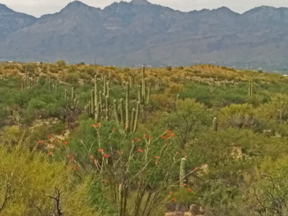 Tucson sits at 2600 feet in the high Sonoran dessert, surrounded by mountains on four sides--the conical peaks and sharp ridges of the Tucson mountains to the west, the long, craggy ridge of the Santa Catalina mountains to the north, where mount Lemmon peaks at over 9,000 feet, the Rincons to the east, which contains the eastern portion of Saguaro National Park, and further to the south, around forty miles, the Santa Rita's. The vistas are stunning in all directions, and one can understand why this place was settled in the opening of the west.
Tucson sits at 2600 feet in the high Sonoran dessert, surrounded by mountains on four sides--the conical peaks and sharp ridges of the Tucson mountains to the west, the long, craggy ridge of the Santa Catalina mountains to the north, where mount Lemmon peaks at over 9,000 feet, the Rincons to the east, which contains the eastern portion of Saguaro National Park, and further to the south, around forty miles, the Santa Rita's. The vistas are stunning in all directions, and one can understand why this place was settled in the opening of the west.
It's somewhere north of 30 years since we last visited the Arizona inn in Tucson. Memories were very vague...a sprawling vaguely Spanish style complex with a walled pool area where the thermometer on the wall, in the shade, read 116 degrees......there was much in-pool time that trip. Returning over an Easter weekend getaway, we find a still-sprawling 14 acre complex of villas and casitas in pink stucco with heavy tile roofs, fountains, courtyards and inset Mexican tile, all lushly landscaped with tall palms and trees, trimmed hedges, swaths of lawn, bright flower beds, and garden areas of native desert plants. It's vaguely reminiscent of both the Sonoma Mission Inn, and Las Mañanitas in Cuernavaca, Mexico. (There are however no albino peacocks, guinea fowl or royal crested cranes roaming the grounds--but there are hopping cottontail bunnies). 
The Inn was built in the late 20's, to open in 1930 by Isabella Greenway, a wealthy woman from the east coast and friend of Eleanor Roosevelt. She built the Inn not oblivious to the coming depression, but in anticipation of it, with the intent of providing employment. She operated it until her death in 1953, and it continues to be managed by the fourth generation of her family.
Mrs. Greenway committed to "sunshine, quiet and privacy" for her guests and that promise attracted the Hollywood elite over the years, including Clark Gable, jimmy Stewart, Bette Davis, Bob Hope, frank Sinatra, and many more.
We are lodged a way back a winding path in suite 246, which contains a large bedroom, enormous living room with fireplace and wet bar and private patio with sunning lounges. The furnishings are formal but comfortable. Much of the furniture and decor still in the hotel came from her multiple houses in New York, and from an enterprise she created in 1927 to employ disabled WWI veterans building all manner of furniture, dubbed the Arizona Hut. A full time master carpenter on site maintains all the furniture.
The inn is such a beautiful and peaceful place that many guests rarely leave it. We are happy to spend much time around the grounds...at the walled pool, in the shaded bar, on our private terrace. The food in the bar and dining terrace is very good, if not inspired, so we take most of our meals there rather than driving the strip mall, chain store and big box lined speedways of central Tucson in search of "special" restaurants. We leave the Inn primarily to head north, south, east and west to explore the beauties of the Sonoran desert.
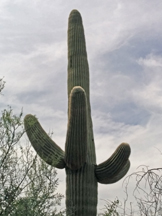 Speedway Boulevard heading east out of town climbs toward the Tucson Mountains, and the road peaks at the narrow saddle of Gates Pass. A scenic turnout provides a spectacular view of the Sonoran desert with its red earth covered with a plaid-work of fuzzy cholla, yellow-spined green barrel cactus, multi-paddled prickly pear, ubiquitous velvet mesquite and brittle bush. Green-barked Palo Verde trees, tall spikey ocotillo and many-fingered organ pipe cactus provide vertical interest, and most dramatic of all are the serried ranks of iconic crooked-arm saguaro cacti marching up the slope to the iron rust-red rocks overhanging above and into the distance.
Speedway Boulevard heading east out of town climbs toward the Tucson Mountains, and the road peaks at the narrow saddle of Gates Pass. A scenic turnout provides a spectacular view of the Sonoran desert with its red earth covered with a plaid-work of fuzzy cholla, yellow-spined green barrel cactus, multi-paddled prickly pear, ubiquitous velvet mesquite and brittle bush. Green-barked Palo Verde trees, tall spikey ocotillo and many-fingered organ pipe cactus provide vertical interest, and most dramatic of all are the serried ranks of iconic crooked-arm saguaro cacti marching up the slope to the iron rust-red rocks overhanging above and into the distance.
It is early April, spring, and much of the dessert flora are abloom. The cholla are topped with yellow, orange or magenta blooms, the ocotillo have flame orange blossoms at the very end of their spikes, the brittle bush and palo verde sport small yellow blooms, and the prickly pear has bright red, yellow or purple flowers. We're lucky to be here when the spring desert is so amazingly colorful. As Oliver Wendell Holmes said "The amen of nature is always a flower".
A winding ten-mile drive through this beautiful desert scape brings us to the Arizona Sonoran Desert 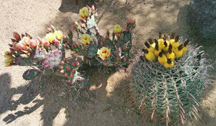 Museum...a combination botanical garden, zoo, aviary and natural history museum. Miles of winding paths explore all the above flora and more--an aviary, butterfly aviary, and desert cat enclosure. Many of the plants are labelled, making it easy to learn a bit about the desert species. We've timed our visit to catch one of the twice-daily raptor free-flies. The museum maintains a stable of various native raptors, some of which are rescues, some born in captivity, and some trained from the wild. They sleep in cages at night, are free to fly in the sun, and daily have the chance to leave, should they choose.
Museum...a combination botanical garden, zoo, aviary and natural history museum. Miles of winding paths explore all the above flora and more--an aviary, butterfly aviary, and desert cat enclosure. Many of the plants are labelled, making it easy to learn a bit about the desert species. We've timed our visit to catch one of the twice-daily raptor free-flies. The museum maintains a stable of various native raptors, some of which are rescues, some born in captivity, and some trained from the wild. They sleep in cages at night, are free to fly in the sun, and daily have the chance to leave, should they choose.
 The bright sunny afternoon we saw the exhibition the two trainers (there are a corps of dozens of volunteers that help out) were flying a common barn owl (gorgeous, and anything but common in appearance), a gray hawk, a peregrine falcon, and a trio of Harris hawks....the only hawk known to hunt cooperatively. The viewing area is just three long railings looking out over a desert swale, and spectators line in several long rows. The owl was first and he flew back and forth, low over the heads of the viewers, landing on a branch or cactus top to pick up bits of meat placed by the trainers. They gray hawk circled high before skimming our heads to perch and grab a snack. Back and forth and around. The presenting docent had early warned parents not to perch children on their shoulders, as that put them in the fly zone. The Harris hawks were perhaps the most interesting, demonstrating their coordination and syncopation in the air that makes them successful cooperative hunters. Naturally the females are the 'lead dogs'. This is a spectacular avian display, and is a don't miss on any trip to Tucson
The bright sunny afternoon we saw the exhibition the two trainers (there are a corps of dozens of volunteers that help out) were flying a common barn owl (gorgeous, and anything but common in appearance), a gray hawk, a peregrine falcon, and a trio of Harris hawks....the only hawk known to hunt cooperatively. The viewing area is just three long railings looking out over a desert swale, and spectators line in several long rows. The owl was first and he flew back and forth, low over the heads of the viewers, landing on a branch or cactus top to pick up bits of meat placed by the trainers. They gray hawk circled high before skimming our heads to perch and grab a snack. Back and forth and around. The presenting docent had early warned parents not to perch children on their shoulders, as that put them in the fly zone. The Harris hawks were perhaps the most interesting, demonstrating their coordination and syncopation in the air that makes them successful cooperative hunters. Naturally the females are the 'lead dogs'. This is a spectacular avian display, and is a don't miss on any trip to Tucson
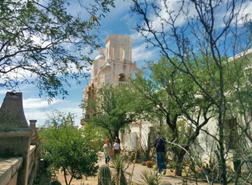 Several miles south of Tucson proper Mission San Xavier del Bac gleams white in the sun against the scrubby reservation desert. The mission, a registered historic landmark, was founded in 1692, and the current building was completed in 1797--the oldest European-style structure in Arizona. The interior is baroque style with a huge elaborate altar, frescoed arched ceilings, tromp l'oeil doors and marbled columns. Ongoing restoration of the mission is being overseen by the non-profit Patronato San Xavier.
Several miles south of Tucson proper Mission San Xavier del Bac gleams white in the sun against the scrubby reservation desert. The mission, a registered historic landmark, was founded in 1692, and the current building was completed in 1797--the oldest European-style structure in Arizona. The interior is baroque style with a huge elaborate altar, frescoed arched ceilings, tromp l'oeil doors and marbled columns. Ongoing restoration of the mission is being overseen by the non-profit Patronato San Xavier.
A line of rough peeled-pole shanties stretches south from the mission--like a mini-mercado. Six or more stands offering souvenirs, candles, refrescoes, snow cones, and variations on Indian fry bread made to order by members of the Tonoho O'Odham clan....who by their appearance dine regularly on their own fare. We followed their lead--hot chewy fry-bread topped with re-fried beans and cheese. The pizza-like bread, cooked quickly to order in hot oil is delicious. It comes plain, sugar covered, or with a variety of toppings. The beans and cheese make it a bit heavier and stodgier, and cry out for cholula hot sauce.....and of course a cold beer.
East of Tucson headed into the Rincon mountains sits the eastern portion of Saguaro National park. Similar in feel to the previous day’s western mountains, the Rincon ridge looms over the park, and the rocky washes wandering down its flank provide some additional visual interest. The flora is virtually identical, but nevertheless has a different feel. The hundred year plus multi-armed saguaro still dominate, but the mix with mesquite, ocotillo, stag horn cholla and the ground hugging cacti and plants--many in bloom--under the expanse of towering cloud-filled sky and the backdrop of the Santa Rita mountains to the north makes a stunning combination.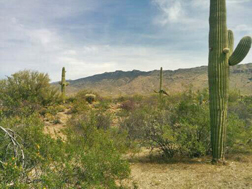
The drivable and aptly-named Cactus Forest Loop takes about an hour to navigate, with frequent lookout stops, and a short walking tour of the desert ecology loop, which provides didactic signage about the interaction of the plant and animal communities of the desert.
Returning to the Inn for a cooling gin & tonic as the heat of the day wanes, and the long shadows of the palms and cacti grow across the desert floor, we reflect that maybe we won’t wait another 30 years to return to this tranquil and beautiful place.